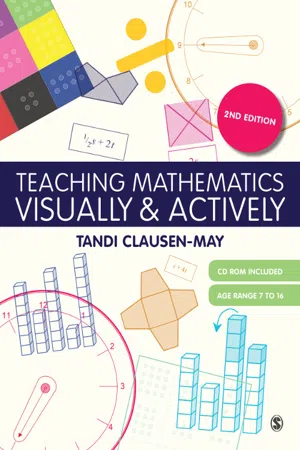Factorising expressions
Factorising expressions involves breaking down an algebraic expression into a product of its factors. This process helps to simplify and solve equations, as well as identify common factors within an expression. By factoring, one can often find solutions to equations and gain a deeper understanding of the relationships between different terms in the expression.
5 Key excerpts on "Factorising expressions"
- eBook - ePub
- Stu Schwartz(Author)
- 2013(Publication Date)
- Research & Education Association(Publisher)
...When we factor in this way, we try to find a number or variable that divides evenly into all the terms. EXAMPLE Factor 2 x + 10. SOLUTION Since 2 divides into both 2 and 10, we factor out the 2. We then get 2 x + 10 = 2(x + 5) Note that if we don’t pick the greatest common factor, we must factor again to get the answer. Thus, to factor 4 y – 16, if we choose 2 as the common factor (an obvious choice since both terms are even), we get 4 y – 16 = 2(2 y – 8). But 2 y – 8 also has both terms with even coefficients, so now we have 4 y – 16 = 2 · 2(y – 4) = 4(y – 4). How much quicker it would have been if we had just chosen 4 as the common factor to begin with. EXAMPLE Factor ab – ac + a. SOLUTION ab – ac + a = a (b – c + 1). Note that a appears in each term. If the problem instead had asked us to factor ab – ac + 2, we would have said it wasn’t factorable. Some expressions are not factorable. Terms with exactly the same variables and exponents but not necessarily the same coefficients, such as 3 x and 8 x, 5 x 2 and – x 2 and xy and xy, are called like terms. The terms 5 x and 4 x 2 are not like terms since the x ’s do not have the same exponents. When we combine like terms by adding the coefficients, we actually are factoring and using the distributive property. EXAMPLE Combine: 4 x + 5 x. SOLUTION 4 x + 5 x = x (4 + 5) = 9 x. We can now use the distributive property to simplify more complicated expressions. EXAMPLE Simplify 8 x – (3 x – 1). SOLUTION EXAMPLE Simplify 6 y − [4(2 y + 1) − 5(y − 2) − 1]. SOLUTION 6 y − [4(2 y + 1) − 5(y − 2) − 1] = 6 y − (8 y + 4 − 5 y + 10 − 1) by the distributive law. = 6 y − (3 y + 13) by combining like terms. = 6 y − 3 y − 13 by the distributive law. = 3 y − 13. OPERATIONS WITH EXPONENTS In the. exponential notation a n, a is the base and n is the exponent. Definition of Positive Whole Number Exponents The exponential notation a n, where n is an integer greater than 1, means...
- eBook - ePub
GMAT Advanced Quant
250+ Practice Problems & Online Resources
- (Author)
- 2020(Publication Date)
- Manhattan Prep(Publisher)
...These can appear in algebraic or numerical expressions: x 18 + 2 x 16 + x 14 → x 14 is a factor of each term → x 14 (x 4 + 2 x 2 + 1) = x 14 (x 2 + 1) 2 → get common denominators, then cross them all off → Factorials are particularly noteworthy, as they often have an abundance of shared factors. For any integer n, the factorial n ! is calculated as follows: n ! = n (n − 1)(n − 2)(n − 3). . . 1. Thus, all the terms in 4! = (4)(3)(2)(1) are also common factors of 6! = (6)(5)(4)(3)(2)(1) = (6)(5)(4!). More generally, factorials are “super multiples.” Without ever computing their precise value, you can tell that they’re divisible by all sorts of numbers. For example: If x is an integer between 7! + 2 and 7! + 4, inclusive, is x prime? x is one of the following integers: 7! + 2 = (7)(6)(5)(4)(3)(2)(1) + 2 7! + 3 = (7)(6)(5)(4)(3)(2)(1) + 3 7! + 4 = (7)(6)(5)(4)(3)(2)(1) + 4 x has one of the following factors, if x is: 7! + 2 = 2 × Integer 7! + 3 = 3 × Integer 7! + 4 = 4 × Integer…so x is not prime! Sometimes a common factor is just a random number buried inside a couple of larger numbers. Find it and pull it out: 10’s in the numerator line up with 5’s in the corresponding digit place of the denominator: Try-It #6-3 If n is a positive integer and is a positive integer, what is the value of n ? n is prime. n < 3 What would need to be true in order for the square root to be a positive integer? The number under the square root symbol would have to be a perfect square. Rearrange the expression to determine whether there are any restrictions that could help narrow down the possibilities before going to the statements. Try to break the numbers down into primes to locate and pull out any existing perfect squares: Pull out common terms: It turns out that you can also pull out the term 7 n − 1...
- Caryl Lorandini(Author)
- 2021(Publication Date)
- Barrons Educational Services(Publisher)
...Conversely, if you divide 12 by 5, the quotient is 2.4—12 is not evenly divisible by 5, and, therefore, 5 is not a factor. The factors of 12 are 1, 2, 3, 4, 6, and 12. One and the number you are trying to factor are always factors of the number. All the other factors will be greater than one and less than the number. It always seems easier when you pull out the factor with its partner or as a pair. A factor pair is the two numbers that are multiplied together to get the product. For example, let’s look at 18. We know 1 and 18 are factors. Moving to 2: 18 divided by 2 is 9; therefore, 2 and 9 make up a factor pair. Moving to 3: 18 divided by 3 is 6; therefore, 3 and 6 make up a factor pair. Moving to 4: 18 is not divisible by 4. Moving to 5: 18 is not divisible by 5. Moving to 6: 6 is already on the list; you can stop. You have found all the factors. As another example, let’s look at 50. We know that 1 and 50 are factors. This will start our list, and we will keep going until we hit a repeat. Looking at exponents DEFINITIONS Base A number that is raised to an exponent. EXAMPLE: Exponent A number that tells how many times the base is used as a factor; in an expression of the form b a, a is called the exponent, b is the base, and b a is a power of b. Exponents can be a little tricky. An exponent is like shorthand or code. You need to learn the code to decipher the meaning...
- eBook - ePub
- Alan J. Cann(Author)
- 2013(Publication Date)
- Wiley(Publisher)
...2 Manipulating Numbers Algebra (from the Arabic, al-jabr, ‘the reduction’) – a form of maths where symbols are used to represent numbers LEARNING OBJECTIVES: On completing this chapter, you should be able to: understand the basic rules of algebra; perform simple algebraic manipulations; identify and manipulate fractions. Arithmetic is concerned with the effect of operations (e.g. addition, multiplication, etc.) on specified numbers. In algebra, operations are applied to variables rather than specific numbers. Why? Here is a classic example: John is 10 years old. His father is 35 years old. After how many years will the father be twice as old as the son? You could try to find the answer by experimenting with different numbers, but this is laborious. The better way is to treat this an algebra problem and write the problem as an equation which we can then solve. Let the father be twice as old as the son in x years time. The son will then be (10 + x) years old and the father will be (35 + x) year old: Therefore, Simplify this by subtracting x from each side to keep the equation balanced: Simplify by subtracting 20 from each side to keep the equation balanced: 2.1. Manipulating numbers To manipulate numbers, you need to know the rules. In mathematics, this is known as the ‘Order of Operations’ – an internationally agreed set of arbitrary rules which allows mathematicians the world over to arrive at the same answers to problems: In algebra, there are two sorts of statement which you need to be able to recognize: 1. A mathematical expression is a string of symbols which describes (‘expresses’) a (potential) calculation using operators (symbols indicating an operation to be performed, e.g. plus, minus, divide, etc.) and operands (symbols which the operators act on), e.g. Expressions do not contain an equal sign, but can often be simplified, that is converted to a simpler form containing fewer terms. 2. A mathematical equation contains an equal sign...
- eBook - ePub
- Tandi Clausen-May(Author)
- 2013(Publication Date)
- SAGE Publications Ltd(Publisher)
...Each part of the expression can be related back to the relevant sections of the pattern, to give it a meaning that can be seen and understood. e) Multiplying Algebraic Expressions We have seen how the physical and spatial concept of the area of a rectangle can help learners to put meaning into both single-digit and long multiplication (see Chapter 3, Models for Multiplication and Division). The same approach may be used to explain what we are doing when we multiply two fractions (see Chapter 5, Fractions). Now this invaluable ‘picture in the mind’ makes another appearance, as we come to multiply a pair of algebraic expressions. Algebraic expressions may be multiplied out sequentially, taking pairs of terms, one from each expression, in turn. For example: Provided learners keep track of the pairs of terms this will generally lead to the right answer. But it may leave learners unsure why the method works. It may be clear where the x 2 comes from – after all, the x in one bracket has been multiplied by the x in the other. But why does the final expression contain all those loose x ’s? What do they mean? How are they different from the x 2 ? Finding the area of a rectangle with sides of length (x + 3) and (x + 1) gives meaning to the whole process. The expressions to be multiplied out may be more complex – for example: If there are negative signs in the expressions then it is helpful to think in stages...




